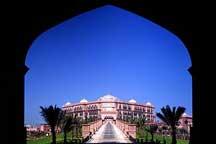 Apr. 17, 2025
Apr. 17, 2025
Weather
The Hui ethnic minority
2009-08-07 10:39 BJTIslamic Religion
The Islamic religion had a deep influence on the life style of the Hui people. For instance, soon after birth, an infant was to be given a Huihui name by an ahung (imam); wedding ceremonies must be witnessed by ahungs; a deceased person must be cleaned with water, wrapped with white cloth and buried coffinless and promptly in the presence of an ahung who serves as the presider. Men were accustomed to wearing white or black brimless hats, specially during religious services, while women were seen with black, white or green scarves on their head -- a habit which also derived from religious practices. The Huis never eat pork nor the blood of any animal or creature that died of itself, and they refuse to take alcohol. These taboos originated in the Koran of the Moslems. The Huis are very particular about sanitation and hygiene. Likewise, before attending religious services, they have to observe either a "minor cleaning," i.e. wash their face, mouth, nose, hands and feet, or a "major cleaning," which requires a thorough bath of the whole body.
Islamism also had great impact on the political and economic systems of Hui society. "Jiaofang" or "religious community," as once practiced among the Huis, was a religious system as well as an economic system. According to the system, a mosque was to be built at each location inhabited by Huis, ranging from a dozen to several hundred households. An imam was to be invited to preside over the religious affairs of the community as well as to take responsibility over all aspects of the livelihood of its members and to collect religious levies and other taxes from them. A mosque functioned not only as a place for religious activities but also as a rendezvous where the public met to discuss matters of common interest. Religious communities, operating quite independently from each other, had thus become the basic social units for the widely dispersed Hui people. Following the development of the Hui's agricultural economy and the increase of religious taxes levied on them, some chief imams began to build up their personal wealth. They used this to invest in land properties and engage in exploitation through land rents. The imams gradually changed themselves into landlords. Working in collaboration with secular landlords, they enjoyed comprehensive power in the religious communities, which they held tightly under their control. They left routine religious affairs of the mosques to low-rank ahungs.
The last stage of the Ming Dynasty and the early years of the Qing Dynasty (1644-1911) saw the emergence of a new system of religious aristocracy among the Huis in Hezhou (today's Linxia in Gansu Province). It came into existence as a result of intensified land concentration which exceeded the boundaries of one single religious community. This made certain imams rulers of a whole series of religious communities, turning them into Islamic aristocrats. They were deified. Kiosks were erected in their cemeteries for Moslems under their jurisdiction to worship. Their position was seen as hereditary. They enjoyed a series of feudalistic privileges as well as absolute authority over their people. The system had been in existence, however, only in some of the Hui areas in Gansu, Ningxia and Qinghai. The Huis in hinterland China had always functioned under the religious community system.
 Mail
Mail Share
Share Print
Print


 Video
Video









 2009 China Central Television. All Rights Reserved
2009 China Central Television. All Rights Reserved